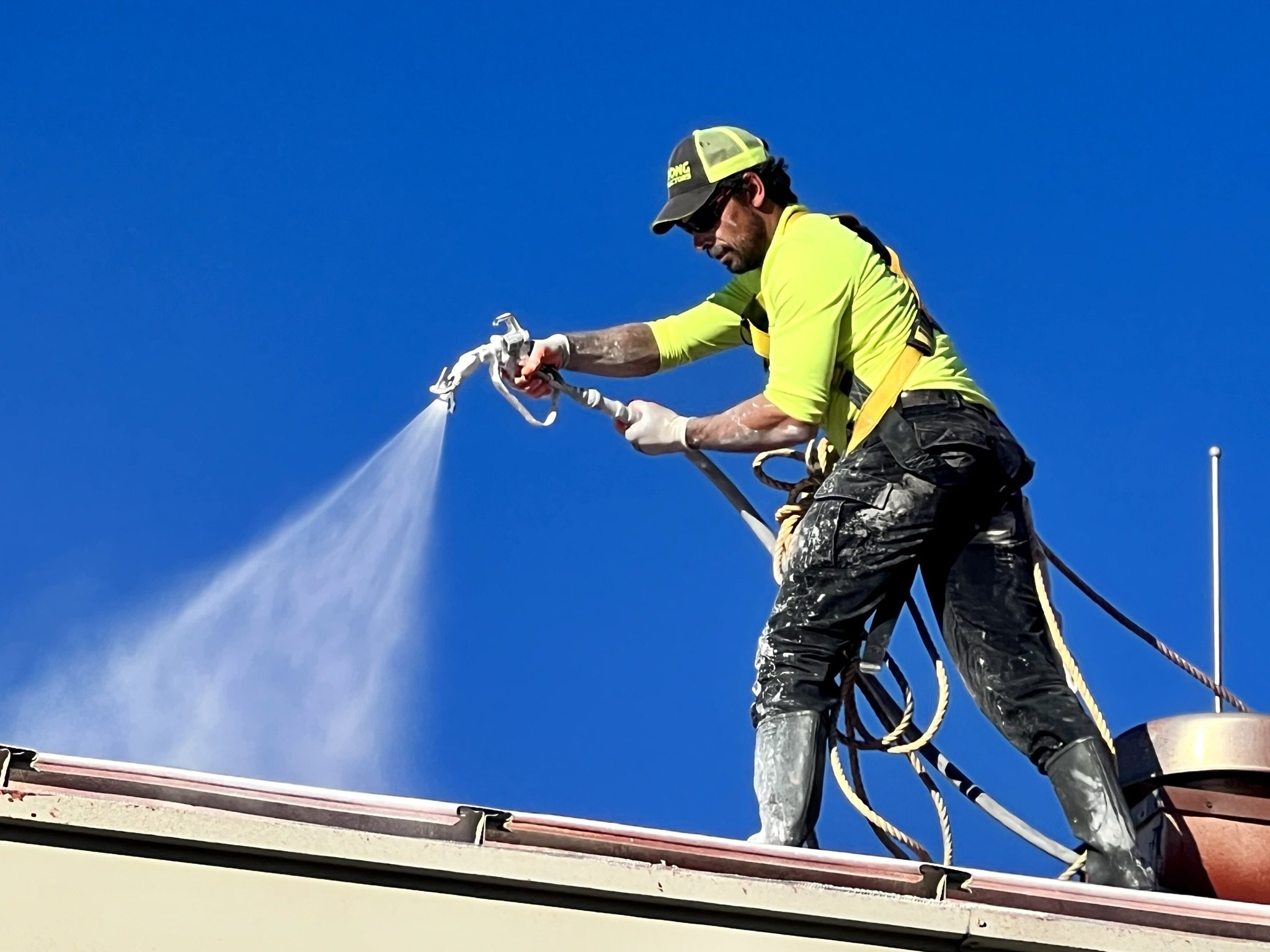commercial roof coatings
The Future of Roofing is Seamless®
Protecting your roof is essential for preserving the integrity of your building and ensuring long-term durability. Our commercial coating services offer a seamless solution to enhance the performance and lifespan of your roof. As one of the leading commercial roof coating companies and contractors, we specialize in liquid-applied waterproofing membranes, providing comprehensive coating solutions tailored to your specific needs. Let us help you safeguard your investment with our top-quality commercial roof coatings.
What is Commercial Coatings?
Also known as liquid-applied waterproofing membranes, are fluid-applied materials spread over a roof's surface to offer protection, waterproofing, and other beneficial properties. These coatings create a seamless membrane adhering to the existing roof substrate, providing a barrier against water, UV radiation, and other environmental elements.
Commonly used in commercial and industrial buildings, they extend roof life, improve energy efficiency, and reduce maintenance costs. Discover the benefits of commercial roofing and coating systems today.
What is Liquid-Applied Waterproofing Membranes?
Liquid-Applied Waterproofing Membranes are fluid coatings applied to surfaces like roofs, decks, basements, and walls to create a seamless, waterproof barrier, protecting structures from water damage.
They are composed of various materials such as polyurethane, acrylics, or bitumen, forming an elastic waterproof seal upon curing. This waterproofing method has a history dating back several decades and has evolved to meet modern construction needs.
Benefits of Liquid-Applied Waterproofing Membranes
Versatile Application
Liquid-applied waterproofing membranes adapt to different substrates, including roofs, decks, basements, and walls, offering reliable protection for commercial and residential properties, as well as infrastructure projects.
Longevity Guaranteed
Engineered for lasting durability, these membranes withstand the elements, providing reliable waterproofing that maintains performance over time, ensuring structures remain protected for years to come.
Cost-Efficient Solution
By creating a durable barrier against moisture, these membranes help minimize costly repairs and maintenance, offering significant long-term savings for property owners and ensuring financial efficiency.
Superior Protection
These membranes form a seamless barrier against water infiltration, safeguarding structures from leaks, corrosion, and mold growth, ensuring long-term structural integrity and durability.
Easy Installation
With user-friendly application methods, liquid-applied waterproofing membranes offer easy installation by brush, roller, or spray, saving time and labor costs for contractors and ensuring thorough coverage.
Eco-Friendly & Sustainable
These membranes are designed with environmentally conscious materials and manufacturing processes, minimizing ecological impact and promoting sustainability throughout their life cycle.
Common Types of Roof Coating
Several common roof coating types are used in commercial and industrial settings, spray polyurethane foam (SPF), silicone, acrylic, urethane, and polyurea. Choosing the right one depends on factors like the type of roof, age, weather conditions, and aesthetic preferences. Each type of coating has its strengths and weaknesses, making it essential to consider your specific roofing environment and needs before making a decision.
Acrylic coatings
Acrylic coatings offer durability and affordability, making them ideal for various roofing substrates. They provide excellent resistance to UV exposure and mildew, making them suitable for extreme climates.
Silicone coatings
Silicone coatings are preferred for their UV protection and resistance to ponding water. They maintain flexibility without becoming brittle and require fewer materials to achieve the desired thickness.
Urethane coatings
Urethane coatings boast exceptional strength, durability, and adhesion, making them perfect for areas with high foot traffic. They withstand thermal movement and the effects of ponding water, ensuring long-lasting protection for roofs.
Polyurea coatings
Polyurea coatings provide fast curing times and superior durability, making them suitable for demanding roofing environments. They offer excellent resistance to abrasion, chemicals, and extreme weather conditions, ensuring reliable protection for industrial and commercial roofs.
Appropriate Substrates
Metal
Concrete
Single-Ply
Bitumen
Liquid-Applied Membranes Waterproofing Process
The process of waterproofing using a liquid applied membrane is a detailed procedure involving multiple steps. Beginning with surface preparation and concluding with the curing and finishing stages, each step plays a crucial role in ensuring the effectiveness of the waterproofing barrier.
1. Surface Preparation
Before the liquid membrane application, thorough surface preparation is essential. This involves ensuring that the surface is clean, dry, and free from any debris or loose particles. Typically, this is achieved through power washing.
Additionally, any existing cracks or joints should be sealed using a suitable sealant to prevent water penetration.
2. Primer Application
The application of a primer is a critical step to ensure strong adhesion between the waterproofing membrane and the substrate. Without proper adhesion, the effectiveness of the waterproofing system can be compromised.
Conducting a peel test is also recommended to assess the bond strength. Primers not only enhance adhesion but also contribute to the longevity and performance of the waterproofing system.
3. Application of the Liquid Waterproofing Membrane
After the primer has dried, apply the liquid membrane. These systems are commonly cold applied using brushes, rollers, or specialized sprayers. Spray application is particularly efficient for large areas. Typically, two coats are needed, with variations depending on the system type: wet-on-wet or two-coat.
4. Curing and Finishing
After the liquid membrane has been applied, it is left to cure. The curing time can vary depending on the product and environmental conditions. Some systems offer fast-curing properties and can tolerate rainfall within a few hours of application.
Once cured, additional coats with special properties, such as anti-slip or extra hardness, can be applied if necessary to meet specific requirements, such as heavy traffic areas.
Best Practices for Liquid Waterproofing
Professional Assessment and Quality Contractors
Before installation, a professional assessment is crucial to select the right liquid waterproofing product. Quality contractors ensure proper installation, extending the system's lifespan.
Maintenance Tips
Regular inspections, preferably yearly or every six months for commercial systems, are essential to maximize the membrane's lifespan. Inspections detect potential issues for timely repair, preventing costly problems.

















